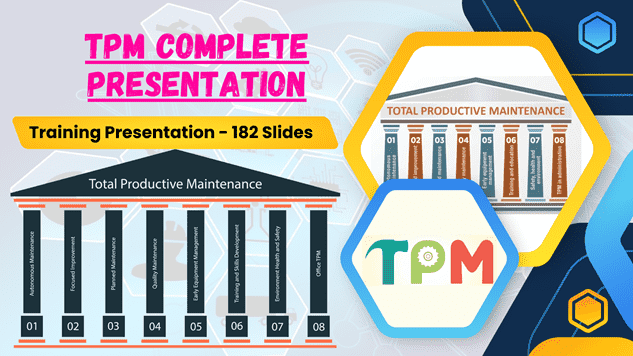What is an equipment breakdown?
→ That results in a stoppage of production or service and an impact on the business.
→ Equipment breakdown can include manufacturing equipment, electrical systems and sub-systems, heating and cooling systems, computers, telecommunications infrastructure, etc.
Table of Contents:
- What is an equipment breakdown?
- Reasons for Machine Breakdowns and Impact on Business
- Five Types of Equipment Breakdowns
Reasons for Machine Breakdowns & Impact on Business:
→ Refer to the below-mentioned most common reasons for breakdowns:
- Wear and tear,
- Mechanical failure,
- Electrical issues,
- Operator error,
- Environmental factors like weather temperature changes, etc.
→ Equipment breakdown can impact operations and lead to downtime.
→ Downtime converts into a loss of productivity, which leads to financial loss.
→ When equipment breaks down, it is necessary to find the root cause of the problem so we can prevent it in the future.
→ Now we will learn about the Five Different Types of Machine Breakdowns.
→ Also, You can visit 7 Types of Abnormalities Presentation.
Five Types of Equipment Breakdowns
→ Five types of Equipment Breakdowns are mentioned below.
- Forced Deterioration
- Natural Deterioration
- Weak Point Part
- Out of Operating Condition
- Lack of Knowledge
→ Now we will discuss all the causes in detail.
1. Forced Deterioration:
→ Forced deterioration refers to the accelerated decline in equipment or material performance or condition due to external factors.
→ In other words, we can say that Forced Deterioration is the reduction in the functionality of machines due to improper usage by operators.
→ Let us take one example to understand this concept:
→ Assume a car that is constantly used in overload conditions and never changes oil.
→ That is an example of Forced deterioration and it causes parts to wear out at a much faster rate.
⏩ The most common causes of Forced Deterioration are mentioned below.
- Lack of Cleaning (accumulation of Dirt & Dust)
- Lack of Inspection (e.g. loose nuts, bolts, etc)
- Lack of Lubrication
- Lack of Re-tightening
- Improper use
- Overloading
→ The impact of forced deterioration leads to a reduction in functionality, efficiency, and lifespan of the equipment.
⏩ How to prevent the Forced Deterioration?
→ Refer to the below-mentioned countermeasures to prevent Forced_Deterioration:
- Following proper operating procedures
- Implementing preventive maintenance plans (cleaning, lubrication, inspection)
- Avoiding overloading
- Implement the visual control for better understanding by all team members.
2. Natural Deterioration:
→ Natural deterioration refers to the gradual degradation in the condition, quality, or functionality of equipment or machines due to normal wear and tear.
→ There are not any external damaging factors or forces involved.
→ Every Mechanical Part has a limited lifespan, therefore even under basic conditions, natural_deterioration will occur.
→ Let us take one example to understand this concept:
→ Assume a car that is constantly used in normal conditions.
→ Over a period of time the tires, clutch, and brake pads wear out due to normal wear.
→ That is an example of Normal deterioration.
⏩ The most common causes of Normal Deterioration are mentioned below:
- Friction and contact between parts
- Environmental Factors
- Mechanical Wear and Tear
- Material Fatigue
- Chemical Reactions
- Aging of Components
⏩ How to prevent the Natural Deterioration?
→ Refer to the below-mentioned countermeasures to prevent Natural_Deterioration:
- Preventive Maintenance - Follow the Manufacturer's Recommendations, Develop a Customized Plan, and Keep Good Maintenance Records
- Environmental Control - Temperature and Humidity, Dust and Debris, Vibration Control
- Proper Operation - Train Operators, Follow Guidelines, Avoid Harsh Conditions
- Storage Considerations - Cleaning and Preservation, Covering, Periodic Operation
- Design for Durability - Material Selection, Modular Design, Accessibility for Maintenance
3. Weak Point Part:
→ The weak point of the part is basically a weak design part due to that part the breakdown happens.
→ In other words, we can say that the Breakdowns are caused by components that were not correctly designed to support their function.
⏩ The most common causes of the Weak Point Part are mentioned below.
- Overload
- Overheating
- Corrosion
- Accelerated wear
⏩ How to prevent the weak point part?
→ Refer to the below-mentioned countermeasures to prevent Weak Point Part:
- Identify Weak Points and Implement Targeted Maintenance
- Design Improvements of component
- Spare Parts Management
4. Out of Operating Condition:
→ Equipment Out of Operating Condition means a machine or device that is unable to perform its intended function due to various reasons.
→ Due to out of operating condition, the machine might face different problems like malfunction, breakdown, or some other issue.
⏩ Different Operating Conditions of the Machine are mentioned below:
- Temperature
- Speed
- Air Pressure
- Hydraulic Pressure
- Feed and Depth of Cut
⏩ How to prevent the out-of-operating condition?
→ Refer to the below-mentioned Countermeasures to Prevent Out-of-Operating Conditions:
- One-Point Lessons and Operator Training
- Visual Controls
- Match Marks
- Alarm Systems
- Interlocks
- Preventive Maintenance
5. Lack of Knowledge:
→ Sometimes Equipment fails due to a lack of knowledge of the operator.
→ There are more chances of machine failure if a nontrained operator is deployed on the machine.
→ Equipment competent operators are very important for preventing equipment breakdown due to lack of knowledge.
⏩ Different Examples of Lack of Knowledge:
- How to handle breakdown
- How to operate the Machine
- How to Repair Machine
- How to Install Mchine
⏩ How to prevent breakdowns due to a lack of knowledge?
→ Refer to the below-mentioned countermeasures to prevent breakdown with lack of knowledge:
- One Point Lessons
- Operator Training
- Maintenance Standards
- Work Instructions and SOP
👉 Also Visit Our Popular Articles:
➨ Lean Manufacturing and Lean Six Sigma





إرسال تعليق